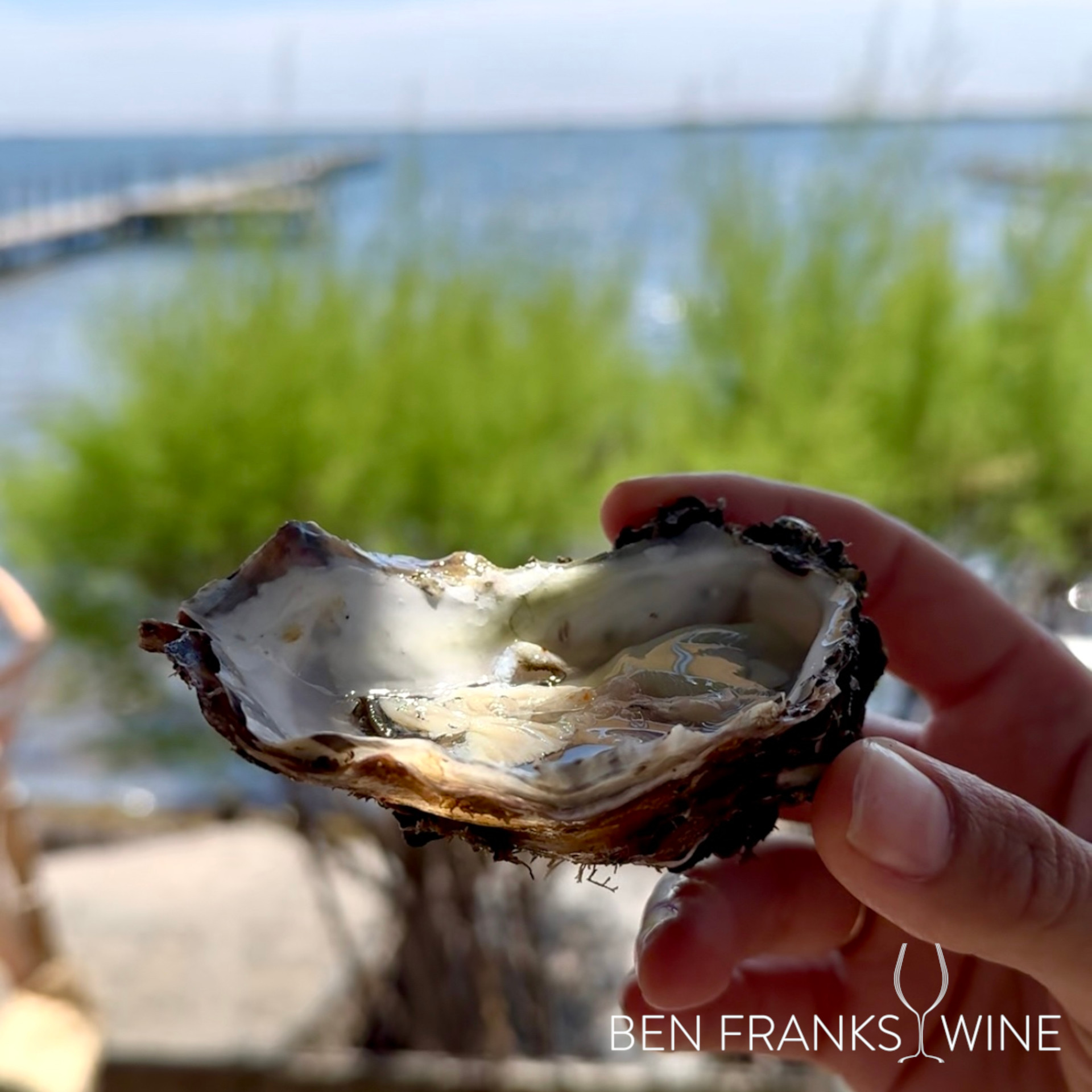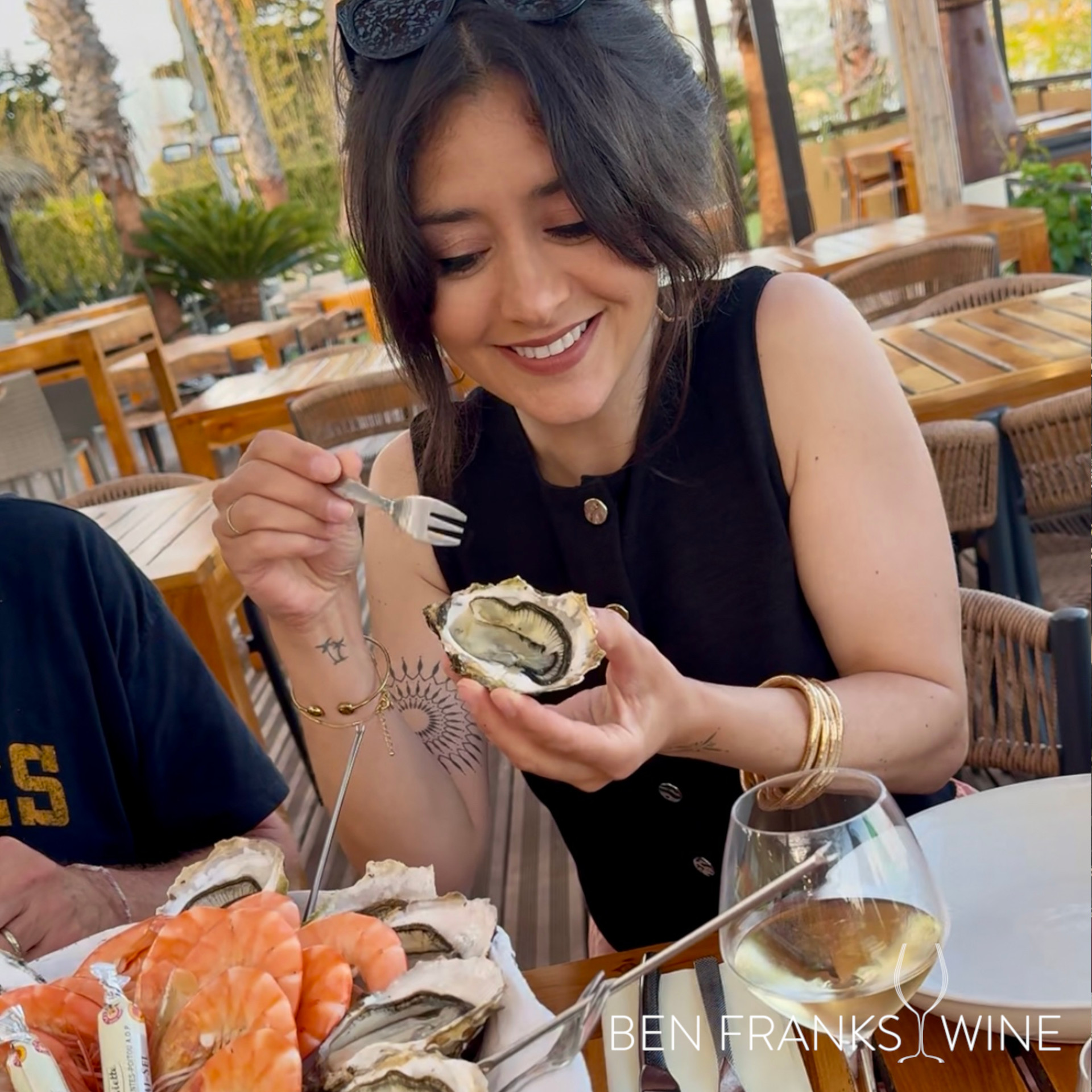Picpoul is one of the hottest white wines in the UK right now. In her latest guest post for Ben Franks Wine, Sophia Longhi shares her recent experience travelling to the Picpoul region, the wines affinity with oysters, and interviews cheese and wine expert Jessica Summer about the best Picpoul and cheese pairings.
Picpoul de Pinet has been having a moment, hasn’t it? It’s been the pub favourite white wine for some time now. If you haven’t noticed it before, you’ll see it everywhere in the beer gardens next summer. People love it. It’s fresh, it’s crisp, it’s juicy, it’s easy-drinking and it’s inexpensive. What’s not to like?
What you might not know is that Picpoul is a fantastic wine to pair with seafood, in particular: oysters. Ordering a platter of briny, glistening oysters with a bottle of Picpoul instead of Champagne will slash your bill in half; and, actually, it’s a much better pairing. Read on to find out why.

Have you ever heard of the saying: “What grows together goes together”? Well, the Bouzigues vineyards of Cave de l’Ormarine, the largest producer of Picpoul de Pinet, are about 200 metres from the Étang de Thau, a saltwater lagoon, where the famous Tarboureich oysters are farmed. I enjoyed one of the most low-carbon meals I’ve ever had whilst sitting on the terrace of Le St Pierre Tarbouriech restaurant, eating a platter of oysters from the lagoon in front of me and drinking a glass of Cave de l’Ormarine Picpoul de Pinet from the vineyards behind me.
Oysters and Picpoul are intrinsically linked to each other – and it goes beyond wine and food pairing. The Étang de Thau is an important part of the Picpoul de Pinet terroir, influencing the character of the grapes and how they grow. The sea mist in the morning hydrates the grapes, which are then dried out in the afternoon by the sun. This process brings complexity to the taste of the wine and its one reason that you experience the incredible acidity in Picpoul, alongside the ripe, juicy fruit. Scientifically-speaking, the sea mist shouldn’t influence the taste of the grapes, but a lot of people feel it does, as Picpoul has a signature saltiness.

The farming methods (and the impacts of them) of both products are also closely linked – one has an effect on the other. Water quality is of utmost importance for the oysters and the residue of any chemical sprays used on the vines will run off into the lagoon. Therefore, treatments in the vineyards are kept to a minimum throughout the year and toxic herbicides, such as Glyphosate, are banned. This has radically improved the quality of the water for the oysters, but because of these restrictions, it has improved the health of the vines and, in turn, raised the quality of the wine.
Back in our pubs, bars and restaurants in the UK, why should we choose Picpoul with our oysters (even if they are such good mates back in France)? Well, oysters are briny and mineral – and so is Picpoul, so the flavours match on the same level. Oysters are also delicate, so you need a wine that won’t overpower them. Big, oaky wines are ill-advised, but Picpoul is light, clean-tasting and usually unoaked. Picpoul is a high-acidity wine, so it brightens the mouth and highlights the umami flavour of the oysters without trying to battle with it. The result is like a refreshing wave rolling across your tongue after you’ve swallowed your oyster down. Bright citrus and stone fruits will linger in the mouth, begging you to do it all over again.

As you can probably tell, I’m a huge fan of this pairing, but oysters might not be for everyone (even though Picpoul certainly is). Take a look at my interview with cheese expert, Jessica Summer, for more perfect Picpoul pairings.
Pairing Picpoul with cheese: An interview with Jessica Summer, cheese and wine specialist and owner of luxury hamper business Mouse & Grape
We all now know about the Picpoul and oysters pairing, but what if you don’t like oysters or, dare I say it, seafood at all? Never fear, Jessica Summer is here! Jess will tell us all about the best cheese and charcuterie matches for all styles of delicious Picpoul.

Jessica, tell us why you think Picpoul is a natural cheese-matching wine?
Picpoul has all the elements you want when pairing with cheese. It has that bright acidity which cuts through creaminess so beautifully. There are lovely herbaceous and lemony notes that complement grassy, citrusy goat’s cheeses. Then, in the more complex, lees-aged styles, you start to get a bit more weight and structure. That means it can handle something like an aged Comté or Gruyère which have nuttier, deeper flavours. It’s a really versatile wine with a lot more pairing potential than just oysters.
If you’ve got one of the fresh, youthful Picpouls that we see in wine bars and pubs at the moment, what kind of popular cheeses would you order with it?
I would go for a creamy, moussy goat’s cheese, especially one with an ash-coated crinkly rind. I love it when there’s a bit of breakdown happening in the cheese. That’s when it’s gooey and soft around the edges but firmer and mousse-like in the centre. You get a very different flavour experience depending on which part you eat, and the rind brings a little extra funk and texture. Goat’s cheese has this lovely lactic, grassy and citrusy profile which pairs so well with the mineral and stone fruit notes in Picpoul. If you want to keep it light and creamy, you could also go for burrata with grilled peaches, stracciatella with grilled leeks and pistachios or mozzarella and tomatoes. Be mindful what you pair with them and go for light vinaigrettes and olive oil topped with grated lemon zest. Think summery Mediterranean dishes, perfect for long summer days and chilled wine.
And what about the more complex Picpoul wines?
Now you’re talking! When Picpoul has spent time on lees or has a bit of age to it, you start getting bready, biscuity, richer notes and that means you can be a bit bolder with your cheese choices. I absolutely love Cornish Kern or an aged Comté with that style. You get this gorgeous mix of caramelised nuttiness from the cheese and stone fruit or pear drop flavours from the wine. You could also play with a creamy blue. I’d steer clear of Roquefort as it’s quite punchy and might overpower, but something like Fourme d’Ambert, Bleu d’Auvergne or even British Beauvale would be delicious. The creaminess balances with the freshness of the wine and the saltiness of the blue brings out the fruit in the Picpoul.
Let’s move onto meat. Do you think we can enjoy a lovely charcuterie board with a Picpoul de Pinet in hand?
Oh absolutely. I’d go for a good saucisson or something with a bit more fat like coppa ham. The fatty cuts work so well because the acidity of the wine cuts right through and refreshes your palate. It’s a really satisfying contrast and so moreish. I’d serve little slices on crackers with a couple of cornichons for a fun canapé or aperitif board. A simple dish but really tasty and classic.
Are there any other great Picpoul and food pairings we should know about?
In similar vein to oysters, Picpoul shines with raw fish like ceviche or sushi. I also love it with seared tuna steak. When it comes to cheese, I think it works best with styles that haven’t been melted into dishes. So, not cheesy pizza, lasagne, macaroni or things with a thick bechamel sause. I think these dishes are too heavy and oily. Picpoul, especially the more readily available in the UK is more delicate and has a saline edge which just sings when you match it with bright, fresh, creamy cheeses and similar light dishes.
You visited the Languedoc too in order to discover Picpoul de Pinet. What was your best food and Picpoul moment there?
There was one dish I’ll never forget. We had the most beautiful seabass ceviche made from fish that had been feeding on oysters. It was served with toasted sesame seeds, a little sesame oil and some salty sea greens. It was so fresh and zingy and the Picpoul just lifted everything. I also had a knockout cheeseboard with local cheeses from Les Fromages du Salagou. They were all young, lactic styles, more dense than gooey, and they worked brilliantly with the local Picpoul.
Thanks Jessica for your brilliant wine and cheese insights, as always!
—
Tried Picpoul you love? Share your experiences with Sophia and Jessica below.






